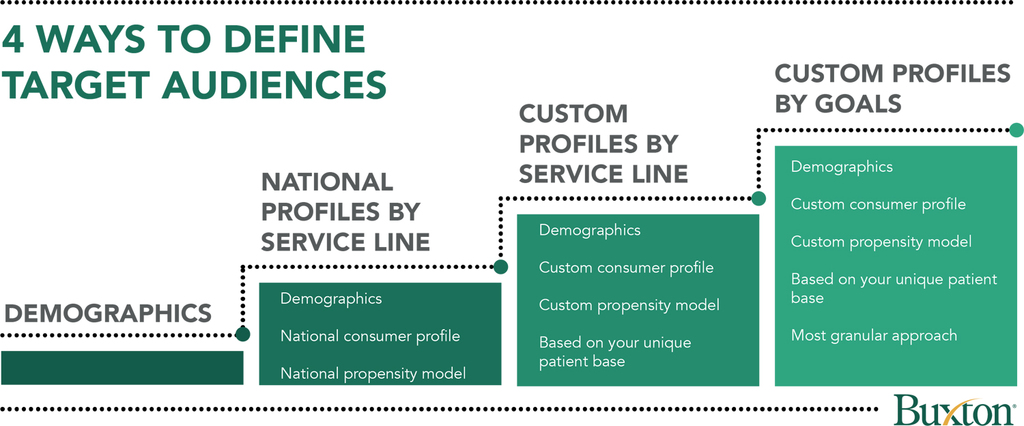Beyond Demographics and National Profiles: Targeted Marketing in Health Care Today
// By Nikki Viner //
 Targeted marketing is a strategy intended to match the right messages with the right consumers at the right time. To do this successfully, you must first define the audience you want to reach. The health care industry has used various approaches for determining target audiences for many years, but today the options for developing those target lists are changing.
Targeted marketing is a strategy intended to match the right messages with the right consumers at the right time. To do this successfully, you must first define the audience you want to reach. The health care industry has used various approaches for determining target audiences for many years, but today the options for developing those target lists are changing.
The following summarizes common approaches to defining target audiences and alternatives helping health care providers take their results to the next level.
Basic Approach: Demographics
Perhaps the most common method of defining target audiences today is basic demographic criteria. In this approach, a health care marketing team would define characteristics common across all patients they are trying to reach. For example, if you planned to market your system’s labor and delivery services, your audience would be all women ages 19-35.
Demographic data is readily available and inexpensive, making it a widely used method of defining audiences. The problem is that demographics don’t reflect the lifestyles and consumer propensities that influence a person’s likelihood to actually use the medical services in question.
Another Common Approach: National Profiles
Another common method of target audience development is nationalized service line segmentation models available through popular health care marketing vendors. These solutions allow you to identify potential patients for various service lines based on profiles developed from national propensity data. If we were to apply a national profile to our previous labor and delivery marketing example, you could market to women who have a higher likelihood of being interested in starting a family, and avoid sending messages to those who are less likely to have those interests.
This is an improvement over using demographic data alone because it takes into account consumer propensities. Because this approach is an off-the-shelf solution, it’s also quick to implement and relatively inexpensive. But like the use of demographics, this approach to audience development still lacks the customization that makes targeted marketing so powerful.
Better Approach: Custom Profiles by Service Line
A custom profile analysis or propensity model allows you to go deeper by using your own organization’s data to identify the most important audience segments within your unique patient base. It accounts for nuances of the population in your operating regions rather than relying on national profiles.
If your organization has never built a custom consumer propensity model, it’s a good idea to begin the analysis by identifying key consumer groups at the service-line level. This is a great first step in tailoring marketing communications to the consumers most likely to use each type of service offered by your unique health care brand. For example, you may study the characteristics of your current labor and delivery patients to identify the common factors present in women who choose to use your services over those of a competitor.
“…using direct mail to reach young women in the labor and delivery audience would be the wrong decision, since this targeted group is typically more receptive to radio and social media.”
Defining custom profiles should also include determining media channels that consumers interact with most. Media preferences need to be considered when executing any type of marketing campaign. In the labor and delivery example, marketers could accurately select an audience but ultimately miss the mark if they select the wrong channel. For example, using direct mail to reach young women in the labor and delivery audience would be the wrong decision, since this targeted group is typically more receptive to radio and social media. By studying media preferences as part of the custom profile analysis, you can ensure that your audience, message, and channel selection are all aligned.
Next-Level Approach: Custom Profiles Based on Your Goals
Identifying your organization’s key consumer profiles by service line is good, but wouldn’t you rather acquire more patients who are the right payer type for each service line, or patients who are less likely to churn? Once you’ve established your base profiles, consider diving deeper into service lines to take your audience segmentation to the next level.
“Study your churn data to identify which patients are at risk of churning so you can implement proactive strategies to retain them.”
Consider building propensity models for the following:
- Payer type – If your organization caters to specific payer types or needs to acquire more of a certain payer type to reinvest or fund your mission, then profiling at this level can be an important tactic.
- Churn risk – Targeted marketing isn’t just for patient acquisition; it can also play an important role in patient retention. Study your churn data to identify which patients are at risk of churning so you can implement proactive strategies to retain them.

As health care organizations come out of the coronavirus pandemic and begin to reinstate service-line marketing, custom profiles can help them target the right consumers using a more granular approach.
The possibilities for profiling are nearly endless, so consider which insights would be most helpful in reaching your organization’s goals. For example, you may want to reach women in your region who are most likely to choose you for labor and delivery services and who also are commercially insured. The commercially insured population will be temporarily smaller following the
pandemic, which means that reaching this audience will be even more competitive for a time. By building a propensity model to identify women who meet that criteria, you can execute a much more targeted and effective marketing campaign.
“At the beginning of the COVID-19 outbreak, elderly consumers and those with chronic health conditions needed to hear a different set of messages than those considered to be low risk. Parents with children had different questions than adults without children in the home.”
When It Matters
The approaches outlined above can improve the effectiveness of any marketing campaign, but they are especially important in certain scenarios.
- Marketing self-select services — The sweet spot for targeted marketing is self-select services, where the consumer is not required to have a referral to see a provider (e.g., orthopedics, primary care, OB/GYN). In this scenario, the consumer has a choice about when, where, and with whom to receive treatment, which means that marketers have the opportunity to influence the decision-making process. While many of these service lines have been temporarily shut down, the demand is still present. Identifying the services you offer that fit this category and prioritizing them during your marketing model development process will prepare your organization to launch campaigns to recover lost revenue as soon as it is safe to begin offering the services again.
- Marketing during a crisis – If you use one-size-fits-all marketing during a crisis, then you will have to use messaging that applies to every recipient. That approach inevitably leaves portions of your audience with unanswered questions. For example, at the beginning of the COVID-19 outbreak, elderly consumers and those with chronic health conditions needed to hear a different set of messages than those considered to be low risk. Parents with children had different questions than adults without children in the home. If you wait until a crisis happens to define your consumer personas, then it will be too late to implement effective, personalized targeted marketing. Taking the time to define audiences now allows you to better communicate with consumers during emergencies.
The Bottom Line
Custom profiling and propensity modeling may not have been widely available to health care marketers in the past, but it’s an important trend being leveraged by a growing number of health care providers today. As the industry shifts its focus from fighting the COVID-19 pandemic to recovery, having a deep understanding of current and prospective consumers by service line will be essential to reaching new patients, reestablishing bonds with existing patients, and recovering lost revenue from elective procedures. Diving deeper into the characteristics of the audience you want to reach ultimately yields more effective and efficient campaigns, which allows health care marketers to maximize their marketing budgets and results.
Nikki Viner is vice president at Buxton, a consumer analytics firm that advises health care organizations on marketing strategy and more. She has more than 10 years’ experience in health care, leading consumer analytics efforts for Mercy, a health system based in St. Louis.
